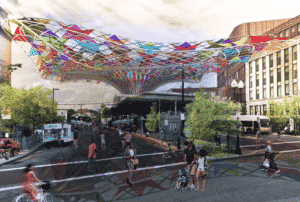
Shade structures, misters and other design interventions dominate ULI Boston/New England's proposals to help Roxbury's Dudley Square (pictured) and other areas around Greater Boston cope with climate change-driven excessive heat. Image courtesy of ULI Boston/New England.
Flooding isn’t the only threat Boston faces thanks to climate change: Extreme summer heat is in the forecast as the 21st century grinds on. In response, the Urban Land Institute is proposing a series of interventions to help area cities and developments cope.
According to the Centers for Disease Control, extreme heat is now the top weather-related cause of death in U.S. cities. Climate scientists predict by 2070 summers in Greater Boston will feature 90 or more days of 90 degree-plus temperatures – making Boston feel more like Birmingham, Alabama. The hottest areas of the city are those impacted by the heat island effect, where dense concentrations of heat-absorbing pavement, buildings, and surfaces cause temperatures to rise.
Over the summer, ULI’s Climate Resiliency Committee convened a charrette of more than 70 members with expertise in development, urban planning, landscape architecture and sustainability to study heat island effects in Roxbury, East Boston, Chelsea and Somerville, where streets can feel 50 degrees hotter than the surrounding air temperature. The experts developed short-term and long-term solutions for each community, including the addition of trees, grass, green balconies and rooftop gardens to absorb heat.
“Making our communities more resilient to heat will require residents, businesses, land use professionals and governments to work together to design and implement equitable solutions for combating the effects of climate impact,” Kalila Barnett, a stakeholder at the charrette and the Barr Foundation’s climate resilience program officer, said in a statement.
One proposal highlighted in the report calls for building a canopy of greenery over the Dudley Square MBTA station, anchoring one end of a cooling corridor that would extend along Ruggles Street. Shade from trees would cool the sidewalks and greenery-covered bus shelters would feature water misters to provide additional relief. The design would enhance the neighborhood’s walkability while providing much-needed cooling.
Recommendations to cool sections of Somerville include utilizing the shaded corridor below the McGrath/O’Brien Highway for pedestrians, cyclists and pop-up vendors, and unearthing a waterway that has been covered for 100 years. Climate experts believe the Millers River, which runs along the MBTA’s Green Line Extension in Somerville, could be used to generate cool air across a newly greened landscape. A recent UK study found even small urban rivers surrounded by green infrastructure can have a significant cooling effect during hot afternoons.
“We need to think different, act now, and develop an all-inclusive vision for the future that focuses on understanding the earth’s ecology within the built environment,” Arlen Stawasz, resiliency strategist at Perkins+Will and co-chair of the ULI Climate Resilience Committee, said in a statement. “Our buildings and infrastructure are currently not designed to withstand extreme heat conditions, and this will have a major impact on our own health and wellness.”
Living with Heat is the follow up to ULI Boston/New England’s 2014 report Living with Water. That publication – featuring the image of a person kayaking through canals built in the Back Bay as part of a decentralized flood control system for the Charles River basin – helped spark a broader conversation about sea level rise in Greater Boston.
“We believe this report will help policy makers and the real estate community acknowledge the consequences of extreme heat and seek forward-thinking solutions,” Michelle Landers, executive director of ULI Boston/New England, said in a statement.




 |
| 

